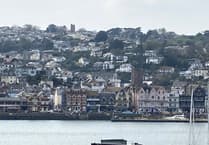A GIANT solar farm covering 30 acres of farmland may be built at Blackawton.
Stretching across five fields, the project would see the installation of thousands of solar PV panels mounted in rows on top of each other on steel posts driven into the ground and protected by a two-metre-high fence around the site, with nine thermal-imaging cameras.
So massive is the operation, it would require regular maintenance works carried out by at least two full-time operational staff from British Solar Renewables.
The project would produce around 5MW – enough electricity to power 1,268 homes for a year.
The planned solar photovoltaic park on land at Oldstone Farm, run by Brian and Graham Andrew, has brought a flood of objections. Protesters claim it would be a ‘blot on the landscape’ that would affect the lives of people living nearby and damage the beauty of the area and its tourist industry.
‘Solar parks are multiplying in the Blackawton area and will blight the local economy,’ said Fiona Kyte, of Main Street, Blackawton.
But planning consultants Alder King from Clifton, Bristol, agents for the applicant, maintain that the proposed solar farm complies with the National Planning Policy Framework and Planning Practice Guidance for renewable energy and low-carbon developments.
The firm said the grade of the proposed site at Oldstone Farm is not classified as ‘best and most versatile agricultural land’.
In a report to South Hams Council, it claims the proposed development will allow continued use of the site for agriculture, with the fenced area of the site being used for livestock grazing during the operational life of the solar farm.
Furthermore, the planning application seeks only temporary permission, with the site being returned to its former agricultural use at the end of the project’s 25-year lifetime.
The proposed solar park is located around 900 metres northeast of the village of Blackawton. The site is currently farmland with a mixture of permanent pasture and arable.
It would be accessed via an existing field entrance from the lane running along the northern boundary of the site.
‘The area covered by solar panels and the associated infrastructure would be less than the total area of the site and therefore provides an opportunity for land to be used for biodiversity enhancement measures, such as the creation of new habitats,’ says the report.
The agents said the applicant has sent letters advising local residents and statutory consultees of the proposal and requesting comments in a mailshot in April, which contained a layout and background information about the applicant and the benefits of the solar park generally.
A consultation event took place at Blackawton Village Hall on April 30, 2015, providing an opportunity for the community to view the proposed site’s layout plan.
Alder King said 29 of the event’s attendees completed the comments form, all of which confirmed that they are supportive of renewable energy schemes.
Furthermore, 16 of the 29 respondents confirmed and agreed that they are supportive of solar energy. The comments from other respondents focused upon the visual impact of the scheme: they felt it was proposed for the wrong place and should be placed on top of commercial buildings.
South Hams Council’s conservation officer has stated that, in order to
make an informed judgement on the potential impact of the proposed development, a robust and detailed heritage-impact analysis will need to be undertaken.
The council’s landscape officer has advised that it is acknowledged that other solar farm sites are within a five-kilometre radius and indivisibility between these is limited by topography and landscape features, such as Devon hedge banks.
But Debbie Mitchell, of Venn Lane, Dartmouth, said a solar farm would spoil the look of the area completely.
‘This area of countryside is one of the most beautiful parts surrounding Dartmouth. I don’t understand why a solar farm has to be located in such an area of beauty when there are other locations that would be much more suitable,’ she wrote in a letter to the council. ‘We now live nearby to Blackawton, but used to holiday at
a location opposite to where the proposed site is outlined.
‘As then tourists, we always chose to spend our holidays in this area in Dartmouth due to the amazing scenery.
‘However, we, and I’m sure others, would not choose to stay in a location where the view is a solar farm.
‘The impact of these planning proposals on the areas surrounding Dartmouth should be considered in relation to an overall strategy to preserve the beauty of the area and in turn the appeal. If these applications continue to be granted, then the area will become a less desirable place to visit and reside in, and it will not be able to differentiate itself from other destinations.
‘This location is really special. Please stop spoiling these lovely places now before it’s too late, and find other, more suitable locations.’
Adrian Kyte, of Main Street, Blackawton, said: ‘We don’t need another solar park in this part of the South Hams. Most of the local economy is based on tourism and the number of existing solar parks is already drawing adverse comments from visitors.’
And Fiona Kyte said: ‘The farmland and the type of agriculture it supports is a major factor in the outstanding character and quality of the South Devon landscape.
‘The solar park remains an alien element out of scale with its surroundings and the perception is that it’s blighting a large area of exceptional countryside.’
She said it would affect the lives of people in the village and that the cumulative effect of solar parks in the South Hams, and particularly between Dartmouth and Halwell, was a cause for concern.
Sylvia Grenfell, of Oldstone Cross, Blackawton, made an appeal for planners to protect the beauty and heritage of the area for future generations.
Mrs D Powell, of Chapel Street, Blackawton, said a solar park in this location would be an ‘industrial and incongruous blot’ not easily screened from view.
Geoffrey Osborn, of Higher Wood Farm, Blackawton, said: ‘Much of the South Hams is already blighted by a rash of solar farms along the Diptford to Totnes road, south of Diptford at Coombeshead, a new eyesore just above Kingsbridge, as well as at the Sportsman’s Arms, with two more to be built nearby at Collaton, to name but a few. We must stop this spread now before it has any more impact on our vital tourist trade.’
Christine Bond, of Greenslade Road, Blackawton, said: ‘I object strongly to this application, the reason being, to take four fields of good agricultural ground, to put up an eyesore of these panels for electricity that’s not needed, but very soon food will be needed, and these fields will be totally useless – surely there are already too many in the South Hams, and our green, lush, productive farmland will be devoid of cattle and sheep, and we shall be importing substandard food to this country.’
Anthony Everett, of Vicarage Lane, Blackawton, said it would be yet another blot on the landscape, adding: ‘We already have one solar farm near to the Sportsman’s Arms and we don’t need or require another. There are two near Diptford, and both of these are huge blots on the landscape.’



